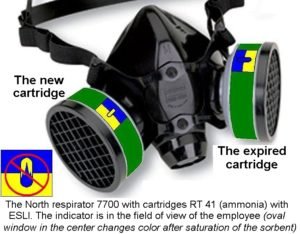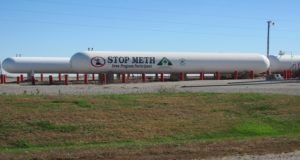Contents
Properties of Ammonia are:
Colour less gas, pungent odour, MP -77.7 degree C, BP -33.35 Degree C, LEL 16% UEL 25%, d 0.771 g/l at 0 degree C, vp 10 atm at 25.7 degree C, vd 0.6, TLV 25 ppm, STEL 35 ppm – irritant Fire hazard low, Explosion hazard moderate when exposed to flame, When heated emits toxic fumes. To fight fire, stop flow of gas.
General preventive measures for Safe Handling and Storage of Ammonia:
- Designing of layout of area with due consideration of adequate natural or mechanical ventilation.
- Use of properly selected material for construction of plant and equipment for handling of ammonia.
- Preventive maintenance of all equipment in proper working condition.
- Avoid contact of ammonia with certain other chemicals, including mercury, chlorine iodine, bromine, calcium, silver oxide and hypo chloride.
First Aid:
- Keep trained first-aiders having the knowledge in the use of first aid equipment for Safe Handling and Storage of Ammonia.
- Provide necessary showers, eye wash station (Safety shower) and oxygen administration apparatus for Safe Handling and Storage of Ammonia.
- Suitable notices should be fixed in convenient places regarding first aid measures.
Personal Protective Equipment:


Provide adequate and suitable personal protective equipment at all time e.g. gas-tight chemical goggles, self contained breathing apparatus, positive pressure hose masks, air line masks, chemical cartridge respirators, hard hats, soft-brimmed hats or caps, safety-toed rubber boots, rubber gloves, rubber apron or rubber coat, sleeves and trousers legs, etc.
Leakage Tools:
- Use large volumes of water directing on leak.
- Leaks of a ammonia should be searched for preferably with Hydrochloric acid solution or with a small cylinder of the compressed SO2 gas. Because of the fire risk, sulphur candles should not be used.
- Gas masks should be located at strategic points under working condition and to be easily accessible in the event of any emergency.
Storage and Handling Controls:
Indoor storage:
- Storage should be cool, dry, well ventilated and protected from external heat sources.
- The building protected with automatic sprinklers, vapour tight electric equipment, good natural ventilation, good floor drainage and adequate exposition venting.
Outdoor storage:
The location should be away from any flammable liquid storage.
Bulk Storage:

- In case of multiple storage facilities, a plan should be prepared for readily and definitely approaching all shutoff valves to be used for isolating various parts of the storage facilities.
- Each storage area should be protected at least by one standard fire hydrant.
- Gauge of glass should be provided with excess flow check valves. The Gauge glasses should not be longer than 120 cm and more than 60 cm between supports.
- Storage tank construction should be of integrity and double wall type known as ‘can in tank’ type.
- Each storage tank shall be equipped with two relief valves mounted on a 3-way hand valve to provide means for repair of faulty valve.
- Install remote controlled valves at the bottom of ammonia storage tank.
- Facilities for creating water curtains around the ammonia storage tanks should be created to absorb ammonia vapours if they leak out, however, care should be taken not add water to the liquid ammonia else it will worsen the situation.
- Non refrigerated ammonia shall be stored in gas tight containers.
- In the event of power failure, provision should be made to run the holding compressors of all the ammonia storage by emergency diesel generating sets so as to compress excess vapour into liquid ammonia (for refrigerated bulk storage system)
- A flare stack should be provided to burn ammonia vapour in case safety valve fails to release ammonia pressure.






Nice. Good service. Very much useful.